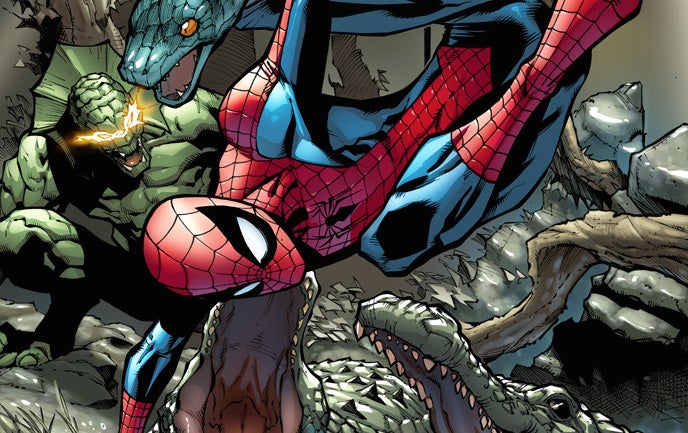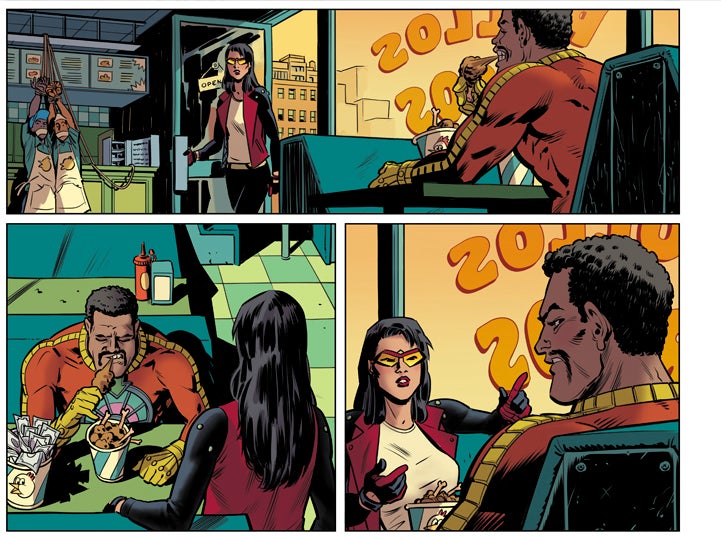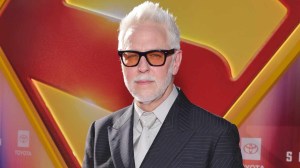Welcome to Public Menace, a new column dedicated to the world’s greatest superhero, Spider-Man.
Videos by ComicBook.com
Yes, the above statement is a bold one to lead with, but it’s far from unfounded. Spider-Man may not be the oldest, best-known, or most powerful character out there. But none of that matters because, as a piece of modern mythology, he is the best hero that our society has conjured within the past century or more.
Just look at the debates regarding who should play the rebooted Spider-Man. With actors from Donald Glover to Matthew Lewis filling fans’ wish lists, we learn what makes Spider-Man so great. Anyone with a sense of responsibility can be him. With a mask covering his (or her) entire face, the bearer of the Spider-Man mantle can fully dissolve into the role while the rest of the world remains none the wiser. The suit grants the ultimate wish-fulfillment, letting us ascend into a much greater entity while still remaining ourselves. Not even a malleable character like Batman lets his readers eat that much cake while having it too.
This isn’t exactly breaking news. After all, these truths were the pillars that Stan Lee and Steve Ditko built the character on. From page-one of Amazing Fantasy #15, Peter Parker could be a antisocial nerd by day, but a cocky adventurer by night. But in today’s society, where personal identity and individuality drive much of what we do as a culture, those pillars have never propped Spidey’s social stock higher. He’s a hero that’s custom built for me, you, and anyone else who’s felt they can achieve more.
In honor of that great power, it’s this column’s responsibility to showcase how and why Spider-Man will always continue to dazzle us. Through interviews, essays, features, and more, Public Menace will, hopefully, discover new ways in which Spider-Man earns that “Amazing” adjective.
With that preamble out of the way, let’s get on to the main event. The most appropriate place to start the journey into Peter Parker’s world is Marvel Comics’ Spider-Office, where Senior Editor Nick Lowe spins the Wall Crawler’s webs into a tight tapestry. Lowe, a longtime Marvel veteran, became Spider-Man’s guiding hand after many successful years shepherding Marvel’s other mega-franchise, The X-Men. And no sooner than when Lowe changed desks, that massive developments swung into Spider-Man’s life. In just twelve months, Lowe pushed Spider-Man through is grandest adventure yet with Spider-Verse, introduced two new successful female characters to Marvel comics, multiple new series, and more.
Below, Nick jumped on the phone for a lengthy chat about his first year in the Spider-Man office. In the exclusive conversation, Lowe discussed Spider-Verse’s repercussions across the entire line, today’s Spider-Woman Revamp, and the importance of diversity throughout his titles. The interview was so massive, we had to break it out into two parts. But that’s great news for you. As part of Public Menace’s launch, we’ll post part two tomorrow as a double feature debut.
Additionally, Marvel provided Comicbook.com with loads of exclusive art from Amazing Spider-Man #16 and Spider-Woman #6. You can see it throughout the interview and in the gallery below.
Spider-Verse is officially over, but how does the event affect the entire Spider-Man line moving forward? What changes are in store for Peter Parker and all of the players involved in Spider-Verse?
Spider-Verse had a huge impact on Peter, and you’re going to see in Amazing Spider-Man what shape that takes. Prior to Spider-Verse, Peter had never really been a leader. Even after coming into Amazing Spider-Man #1 after Superior Spider-Man, Peter saw everything that Dock Ock did by starting Parker Industries and being a leader of men, but Peter never really fit into that mold. But thanks to the events of Spier-Verse, he had to step up. He had to really stop Ock from taking leadership of the Spider-Men himself. In doing so, he saw a different side of himself that he never saw before. He found that being a leader had different demands, benefits as well. He learned that he could be a decent leader. I think it plays into his whole notion of power and responsibility, so that’s one of the big character ramifications for Peter.
Spider-Gwen obviously saw some big ramifications. She went back to her universe, and she’s been Spider-Woman for a long time in her universe, and getting thrown into this huge superhero insanity. It’s thrown her for a loop, as we saw in Spider-Gwen #1, so you’ll continue to see that reaction. There’s something very Spider-Verse related in issue #2.
For Silk, people saw in Silk #1 that Spider-Verse affected her powers a little bit. She’s feeling a little funky coming out of it. But she’s only been in the field as a superhero for a bit, and like Spider-Gwen, being thrown into this big superhero event has changed her world-view. Each character is going to experience a little bit of that. You’re going to see a large amount of that in our Secret Wars Spider-Verse series coming up.
For Spider-Woman, she might see the biggest changes. She changed her costume, changed her mission statement and quit the Avengers, and started working with a new partner in issue #5. That is such a great issue, and I can’t wait for people to read it.
And then we saw something pretty ominous with Kaine as well, right?
True. A mysterious hand came out of what was Kaine and the Other. Readers should keep their eyes peeled for more Kaine in the near future. I can’t really say what that it is, since it’s still very secret, but we’ve got some really cool plans for him.
Awesome. What’s up with Spider-Man 2099 now?
Miguel goes back to his own timeline, but what he finds isn’t pretty. He’s going to have to make some really difficult decisions in the coming days after he returns to his time. The years 2099 doesn’t seem like his time anymore. You’re going to see some stuff from Miles Morales as well. There’s lots of stuff coming up for him. And MC2 Spider-Girl, who we saw in Amazing Spider-Man #15, has a new family member coming out of this. Uncle Ben is joining her family. And we should be announcing some Mayday plans soon, so that’ll be fun.
You just laid out a lot of information there, so I wanted to go back and unpack some of it. You talked about Superior Spider-Man, who went back to his Spider-Verse starting point in Superior Spider-Man #19.
Yes, the loop was closed.
So does this mean that Superior Spider-Man’s story is finally over?
I’m afraid so. His timeline is done-zo, and it’s really sad. But the only thing that gives me reprieve from that sadness is knowing how awesome Superior Spider-Man #30 and #31 were. It was a terrific close-out to that character. When I read the script to issue 30, when he gives the reigns back to Peter, it brought tears to my eyes. It was a beautiful and emotional character arc. That’s the only thing that makes it all ok to me. But, Superior Spider-Man’s circle has closed. We won’t see any more of him, sadly.
At least he enjoyed a fantastic run. I wanted to talk about Spider-Verse’s overall direction. It was interesting to see a Spider-Man tale with cosmic-level stakes. We don’t get those very often, since Spider-Man’s a character who usually sticks with interpersonal stories that rarely venture beyond New York. What was it like taking Spider-Man out of his comfort zone and throwing him into the deep end of the Multiverse?
As one of the first Spider-Man stories I worked on, it was very bizarre (laughs). But, it was a lot of fun. It was on a level that I was somewhat experienced with, because we did this trippy, universe hopping insanity on X-Men with a lot more regularity. It was really fun doing it through Spider-Man’s lens, since this character, like you said, doesn’t normally do this kind of stuff. It’s a big testament to [Amazing Spider-Man writer] Dan Slott, who over the last several years has put Spidey in all kinds of situations that he’s never been in before. He’s pushed him into so many new directions, and it’s so impressive. It’s a testament to his amazing run on the book.
Spider-Verse featured dozens of different men and women underneath the Spider-Man mask, yet they all proved that they were “Spider-Man.” What do you think this says about the role of Spider-Man? Is it a role, or persona, that is bigger than Peter Parker? In your opinion, what–not necessarily who– defines Spider-Man and makes the character tick on a conceptual level?
One of the best things about Spider-Man is the mask that covers his whole face, and the fact that he could be anybody under it. But Peter Parker is also the best character in comics and is, basically, everybody. That said, no one threw that for a loop better than Miles Morales, whose series is the first thing I read when it comes in my comics bundle. And now Spider-Gwen. But I’d have to say, the core is “With great power, there must also come great responsibility.” That might be the best and most important sentence in the history of the English language.
I totally agree. Looking at today’s revamped Spider-Woman, why did you decided to overhaul the series in its fifth issue? Was it your plan to redesign her look and series before it even launched, or did the idea come later?
I came into the Spider-Office wanting a Spider-Woman book, and when I called [Spider-Woman series writer] Dennis Hopeless to pitch him the book, the first thing I said was, “We’re changing the costume.” Don’t get me wrong, the original costume was great and iconic. But, it’s the only costume Jessica Drew has had beyond a few variations. I wanted to shake that up. I’m not the biggest fan of the costume myself, so I wanted to give her something modern. So what you see in issue five is where we always wanted to land. New costume. New status quo. New outlook.
But we wanted to motivate those launches properly. We could have just launched the book after Spider-Verse, but I wanted to get eyes on Jess first. I wanted to make sure that as many people as possible would pick up the book. The best way to achieve that was by spotlighting her in Spider-Verse. Spider-Woman titles have a history of not selling so well. Even when they’re really great, creatively, they only last about 12 issues. I wanted to build a book that would be around for longer than that. I wanted to give it as big of an audience as possible, and I wanted Spider-Verse to motivate Jess’ change and what she was going to do. This change has been coming for a long time.
Cool. And based on the visuals alone, it looks like you’re going for the grounded approach that Hawkeye, Black Widow and even Batgirl picked up. We’re you trying to hit that same street level tone?
Jess’ story had become so big and crazy with her involvement in The Avengers, so we definitely wanted to go street-level. But the bigger inspiration, to be completely honest, was Frank Miller’s run on Daredevil. That’s more of the tone we’re trying to strike than any of these modern comics. I love Hawkeye and what DC is doing with Batgirl. But Frank Miller’s Daredevil is more what we’re trying to hit than anything else.
So the Spider-Verse now has three different female-led books. I might be wrong here, but it seems like your office is producing the most female-led comics per franchise, percentage-wise. As you’ve leveled the playing field with gender diversity in comics and become a leader with that, what have you learned? How has the increased diversity changed your approach as an editor?
So much of this comes down to the incredible staff here at Marvel. Editor Sana Amanat is fantastic. She’s a driving force behind Ms. Marvel, and I go to her for advice for all time on stuff we’re working. Ellie Pyle, who recently left to go work for Vertigo, worked very closely on all of this stuff. I think it’s more the women at Marvel, and the creators at all levels pushing for more. But more than anything, it’s the characters.
But I’d be lying if I said I wasn’t trying to put out more female-focused books. I definitely am. I think being a father to a daughter has something to do with that as well. I just really like these characters, and I’m trying to make different books with interesting voices. It’s a lot of forces coming together, and I’m just thankful to be working with the staff at Marvel and the amazing creators we have. I love that we’re trying to make content that’s different from what we always do. And a big part of that, actually, is Axel Alonso. He’s always pushing us to tell better and better stories, and to diversify our publishing line. And Steve Wacker, before he went to Marvel Animation, paved the way for a lot of this. He pushed this direction a lot with books like Captain Marvel.
Then there’s Jeanine Schaefer, who I shared an office with for a number of years. She has been such a component of the Women of Marvel. I lay a lot of this at her feet for just brainwashing washing me while we shared offices. She always dared me to keep pushing in this direction, and to diversify the content, not just the characters. She wanted to introduce a diversity of content to attract readers outside of Marvel’s readership.
It’s a big team effort, and I don’t think of myself as a leader of that. I’m one part of it, and I hope that we’re doing the right things.
Tune in tomorrow for part two of our interview with Lowe, where he discusses the surprise hit that is Spider-Gwen, how Secret Wars will affect Spider-Man, and which villain should headline the Spider-Man film reboot.













